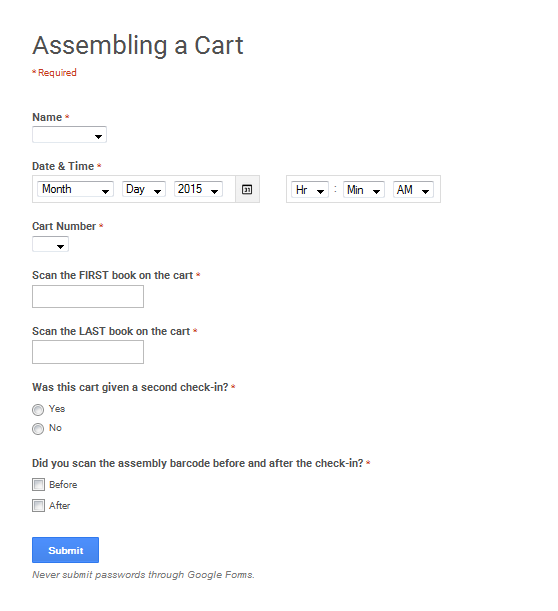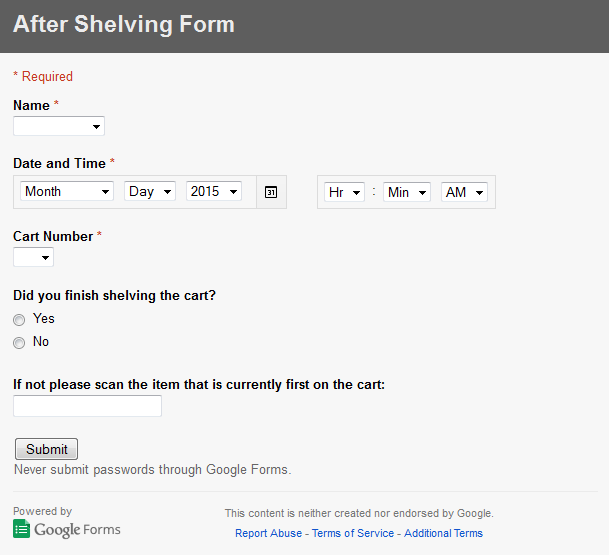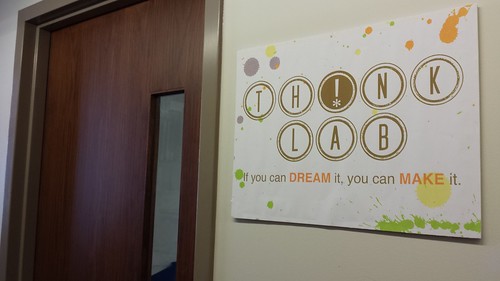I’ve been trying to find a way to begin to talk about my latest job change in the library. I have this ongoing problem of wanting to write all encompassing narratives (it all started when I was 5 and I fixed my mom’s stapler) that ultimately prove to be too overwhelming to finish writing.
So, in my attempt to keep it simple I want to tell you I recently finished making something for my cat.
More specifically I made a cat scratcher pad. One of those cardboard things you can buy at the pet store that encourages your cats to claw it rather than your lovely furniture. I’ve bought a couple in the past and it always seemed to me that it consisted of cardboard pieces glued together and wrapped in some paper. It didn’t seem too complicated and one day I thought, “I wonder if I could make it myself?”. I brought my cardboard to our makerspace, the ThinkLab, and utilized a box cutter, a hot glue gun and some duct tape and out came this:

It didn’t turn out as neat and even as one I’d buy at the store, but it seems fairly solid. I’ll be taking it home later today to see what the cat thinks of it. The cat scratcher pad isn’t anything that complicated or elaborate but in attempting to craft my own I had to think through the process of cutting and gluing it together and as I went along what might make it more structurally sound. I’m sure you are wondering why am I talking about this and what does it have to do with my new job?
Well, in the library we’ve had a makerspace since about 2012 and in that time it has fluctuated in its use and has been making its way along with support from outside faculty and staff as well as the head of the library and library staff. It has lacked a sense of continuity though, as any space would that was being supported by people who had other jobs they had to do, and in the past years has struggled to be a place we kept staffed on a regular basis. Earlier this semester several library staff came together for a meeting and out of that came the decision that I would spend a percentage of my time managing the ThinkLab. I’m grateful to colleagues in the library who have willingly taken on pieces of my old job so that I’d actually have the time to give the ThinkLab a shot.
Now that you have that background back to the cat scratcher pad. Why do I use this as an example of something I created in the ThinkLab? Well, besides being humorous it gets to the heart of what I see the ThinkLab being and it all starts with the simple idea, “I want to try and make that”. Your project doesn’t have to be complicated or even work in the end. The important thing is that you start taking the thoughts in your head and making them in to something real. What excites me most about the space is not the 3D printers, or the robotics kits, or the sewing machines (although all of that is great) it is the opportunity to make something and probably even more importantly break something (the head of the library, Rosemary, is fond of saying that our tagline should be “We’ll help you break things creatively!”). I’m lucky that I work at a university that places great value in our students being creators of all kinds and I’m looking forward to the ThinkLab contributing to the mission of our institution in creating students that think thoughtfully about the things they produce and about the importance of being actively engaged in the world. There is more I can unpack about the pedagogy of makerspaces and certainly I plan to write more about it as I work on programming for the space over the summer, but for now I have to head home and see what my cat thinks of my handy work.






